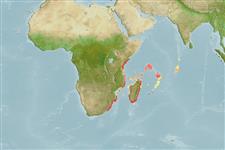Environment: milieu / climate zone / depth range / distribution range
Écologie
marin démersal. Subtropical
Western Indian Ocean: known only from 3 specimens, 1 possibly from Natal, South Africa and 2 from Madagascar.
Taille / Poids / Âge
Maturity: Lm ? range ? - ? cm
Max length : 23.0 cm TL mâle / non sexé; (Ref. 4421)
Description synthétique
Clés d'identification | Morphologie | Morphométrie
Épines dorsales (Total) : 2; Rayons mous dorsaux (Total) : 31 - 32; Épines anales: 0; Rayons mous anaux: 30 - 31. Preserved specimens brown with darker spots; dark brown ring around anus; soft dorsal, anal and pectoral fins pale; caudal fin dusky (Ref. 4421).
Life cycle and mating behavior
Maturities | Reproduction | Spawnings | Egg(s) | Fecundities | Larves
Hutchins, J.B., 1986. Monacanthidae. p. 882-887. In M.M. Smith and P.C. Heemstra (eds.) Smiths' sea fishes. Springer-Verlag, Berlin. (Ref. 4421)
Statut dans la liste rouge de l'IUCN (Ref. 130435)
Menace pour l'homme
Harmless
Utilisations par l'homme
Outils
Articles particuliers
Télécharger en XML
Sources Internet
Estimates based on models
Preferred temperature (Ref.
123201): 21.1 - 25.9, mean 23.7 °C (based on 19 cells).
Phylogenetic diversity index (Ref.
82804): PD
50 = 0.5001 [Uniqueness, from 0.5 = low to 2.0 = high].
Bayesian length-weight: a=0.01995 (0.00943 - 0.04220), b=2.93 (2.75 - 3.11), in cm total length, based on LWR estimates for this (Sub)family-body shape (Ref.
93245).
Niveau trophique (Ref.
69278): 3.5 ±0.4 se; based on size and trophs of closest relatives
Résilience (Ref.
120179): Haut, temps minimum de doublement de population inférieur à 15 mois (Preliminary K or Fecundity.).
Fishing Vulnerability (Ref.
59153): Low vulnerability (13 of 100).
